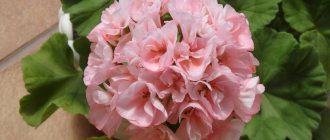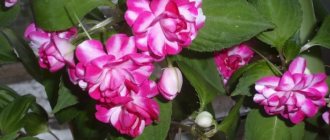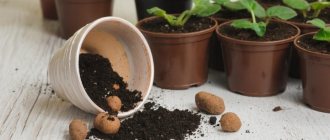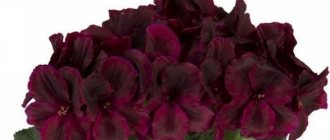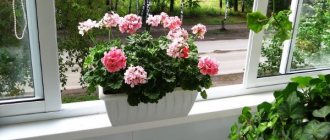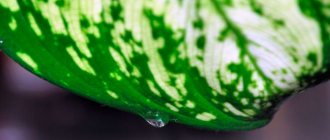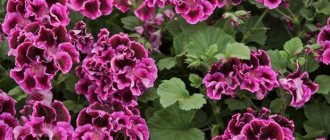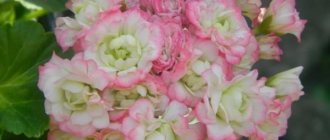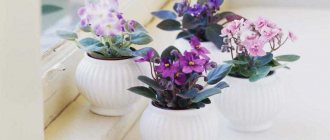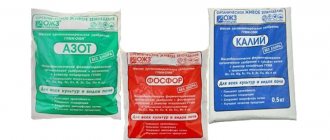Description, history and cost
Dwarf pelargonium is a variety of pelargonium that was obtained artificially as a result of targeted selection. In the process of breeding work, a compact ornamental bush was obtained that does not require molding pruning.
In addition to their attractive appearance, mini pelargoniums have healing properties and a delicate aroma. The smell that flowers emit improves mood and cleanses the air of pathogenic microflora.
You can buy dwarf pelargonium seeds for 125-150 rubles, and cuttings for 300-700 rubles.
Pelargonium Norland: description
This flower from the Geranaceae family is an artificially bred hybrid. It grows well both in apartments and in open ground. This geranium belongs to the zonal species of pelargonium and is quite easy to care for.
Beautiful pelargonium Norland
Pelargonium Norrland is a herbaceous perennial plant in bush form. The shoots are quite powerful and capable of active growth. The size of the bush is tall, the leaves are large, rich green.
A special advantage of the variety is the size and appearance of the inflorescences. Terry pink flowers, shaped like small peonies. The inflorescences are located on a long peduncle. Against the background of the lush greenery of the bush, large flowers look simply amazing.
Appearance and features
Dwarf pelargonium is an elegant and miniature bush, suitable for growing in a small pot - about 15 cm. And although the size of the plant is small, it looks very beautiful and impressive. The inflorescences are arranged in groups and form characteristic caps.
Petals can take on different colors, it all depends on the variety:
- red;
- pink;
- white;
- lilac.
The leaves are always dark green or emerald green.
Features of plant flowering
Pelargonium Odensjo Symfonia - description
Pelargonium is famous for its bright and abundant flowering, which makes the flower very popular. The bush begins to bloom the first buds after wintering at the end of April or May. Flowering continues until September.
Large Pelargonium flowers form lush inflorescences with a diameter of up to 20 cm. There are two types of petal colors: pink and scarlet. Red Pelargonium Norland (Red Sport) has a different description of the buds from the pink one - they are smaller in size and not too densely located in the inflorescences.
Common varieties and photos
You can purchase dwarf pelargonium of the following types, look at the photo.
Jinky
The advantage of the variety is large double flowers of light creamy color . At the very core the petals are deep pink. The plant itself is tender and airy, the leaves are light green in color.
Pink Ice
It is a mini bush that is stocky and branchy despite its compact size. The petals are elongated, terry, and pale pink in color.
Read more about Pink pelargonium and its varieties in this material.
Clatterbridge
This decorative crop belongs to the group of zonal dwarf pelargoniums. The peculiarity of the variety is its intense flowering . The buds are terry type and bright red in color.
Silk Moira
The variety is distinguished by salmon-colored petals. It is not picky in care, and the process of forming a bush also does not require much effort.
You can learn more about Pelargonium Silk and its species - Moira, Laguna, Aurora and others, as well as see photos of flowers here.
Madame Maleron
This variety does not bloom at all, but its main advantage is its dark green leaves with a light edge.
Some of the most popular varieties: top 10 with photos
The genus Pelargonium includes about 250 species, but only a few of them are used in indoor floriculture and landscape gardening. Species diversity and a large number of interesting varieties allow you to choose the best option for garden design.
Because of its ivy-like leaves, the Ice Rose variety is called ivy-leaved.
Pelargonium ivy-leaved Ice Rose stands out for its medium-sized, dark green foliage. The compact plant produces fairly large white flowers reminiscent of roses.
The dissected purple-pink flowers of Mons Ninon honeycomb with a white border along the edge prefer to grow on the sunny side
The fragrant pelargonium Mons Ninon from the Unicuma group stands out for its strongly dissected and curly leaves that exude the scent of rose and lemon. The flowers are purple-orange-pink.
Pink-coral flowers with serrated edges of the petals of the Diana Palmer variety show a lush bloom
Diana Palmer geranium produces pinkish-coral flowers with serrated petal edges. The leaves are juicy green in color and average in size.
After a month and a half, a cutting of the Natalie variety grows into a bush with semi-double pink-coral flowers.
The dwarf variety of zonal pelargonium Natalie produces small bushes and incredibly attractive, semi-double and very large peach-colored flowers with a delicate edge.
The buds of the Dovepoint variety produce fairly dense inflorescences with pale pink flowers
Zonal double geranium Dovepoint stands out for its large double pale pink flowers with iridescence, which are collected in dense large inflorescences on thick and short peduncles.
The Rembrandt variety with large flowers of a plum-ink hue prefers wintering in cool conditions.
Royal pelargonium Rembrandt is distinguished by large inky purple flowers with a large wave along the edges of the petals and a distinct purple mesh.
The variety Fringed Patricia Andrea with coral-red tulip-shaped flowers stands out for its rapid growth and appearance
Pelargonium tulip-shaped Fringed Patricia Andrea produces shiny green leaves and flowers with coral-red petals, which are clearly veined.
The Blue Spring variety stands out for its large, densely double flowers with a lilac-pinkish paint finish.
The Blue Spring ivy hybrid, resulting from crossing zonal and ivy-leaved pelargoniums, is suitable for growing both indoors and in balcony boxes and flower beds.
The variety Vectis Rosebud with deep red rosettes stands out for its long and lush flowering
The rosebud variety of pelargonium Vectis Rosebud is a magnificent, densely double flower with small and neat tassels, dark green elegant foliage and bright red-burgundy inflorescences.
The Lieke variety, displaying a spherical bush with large soft pink inflorescences, is popular in landscape design
Pelargonium Lieke from the zonal series Tuscany (Toscana) stands out with very large inflorescences of a delicate pink color with a pinkish-red eye, forming a small spherical bush.
Landing
In order for the plant to fully grow and develop, you need to know the main features of planting a crop :
- choice of location;
- illumination;
- temperature;
- soil composition.
Lighting and location
In order for the mini-bush to bloom for a long time and beautifully, carefully choose a well-lit place. With sufficient light, the plant will have bright not only petals, but also leaves. If there is a lack of light, the decorative appearance of the flower will fade : there will be fewer inflorescences, and the leaf blade will turn pale.
You need to choose a place for pelargonium so that there is no direct sunlight. At midday, the flower needs to be shaded. In winter, so that the plant does not lose its decorative appearance, it will need additional lighting using lamps.
For the correct formation of the crown, the flower pot should be turned to the window in different directions. Then the sun's rays will be able to reach all parts of the plant, and it will begin to grow evenly.
Soil requirements
Dwarf pelargonium does not have any special requirements for soil composition . It is important to provide the flower with good drainage to prevent moisture stagnation in the pot.
Soil with a neutral or slightly alkaline reaction is best suited for the plant. If the soil is acidic, then it is necessary to add ash to it.
To prepare the soil mixture, you can mix the following components in equal proportions::
- humus;
- leaf soil;
- turf;
- river sand.
Flower propagation methods
When breeding geraniums, both seed propagation and flower division are used.
Reproduction by flower division
When replanting a plant in the spring, it is recommended to simply break the bush into several parts. Plant each part in a separate hole and water generously. The survival rate with this method is more than 95%.
Dividing the bush before spring planting
Seed propagation
When propagating from seeds, it is recommended to grow seedlings. When propagated by self-sowing, the survival rate is no more than 5-7%.
The time for planting seedlings is at the end of April - beginning of May. Seeds can also be scattered in late autumn.
Home care
Temperature
In summer, dwarf pelargonium prefers to grow in moderate temperatures - 17-23 degrees Celsius. Overheating must not be allowed. In winter, the optimal temperature remains 12-13 degrees, but not higher, since during this period the flower rests.
Watering
Dwarf pelargonium responds positively to soil moisture, so you need to water it regularly and abundantly. In summer, moisturizing is done every other day, and in winter – once a week. It is important to ensure that the soil dries thoroughly before watering .
It is not necessary to spray dwarf pelargonium, as this procedure injures the leaves and flowers.
Top dressing
The plant must be fed regularly, especially during the growing season - from March to November. In winter, the plant does not require additional nutrition, as it rests.
Phosphorus or potassium should be used as fertilizing , and it is important not to overdo it with nitrogen. If this element is in excess, the green mass will begin to grow actively, but flowers will not form. Complex fertilizers must be applied once every 2 weeks.
Molding
In order for the bush to be lush, it is necessary to regularly pinch out young shoots. This manipulation will enable the plant to form a large number of lateral branches, as a result of which the decorative appearance of pelargonium will improve.
Sometimes the shoots become very elongated during the winter, so in the spring they have to be removed by 1/3 of their growth. If the cuttings are healthy and strong, they can be rooted. Then there will be even more beautiful and graceful pelargoniums in the house.
Pelargonium variety Dovepoint (Dovepoint) - features, how to plant and care
The pelargonium dovepoint flower (geranium) is one of the popular, easy-to-care plants. The crop is grown only at home. Pelargonium looks good on window sills, balconies, flower beds, lawns, parks and squares.
Description of the pelargonium variety Dovepoint and its characteristics
Pelargonium belongs to the Geranaceae family, which has more than 400 species of flowers. This variety has quite dense inflorescences. Lush double flowers look gorgeous, changing color from white to soft pink. In the description of Dovepoint pelargonium bushes, their compactness is noted. The flower is characterized by abundant and long-lasting flowering.
Pelargonium in a pot
History of origin
The name of the plant comes from the external resemblance of the fruit to the beak of a crane. India and South Africa are considered the birthplace of pelargonium. It was from these countries that the first varieties came to European countries. In Russia, the plant became widespread in the 19th century. Flowers were grown to decorate parks and palace squares.
Indoor pelargonium Dove Point is a zonal plant. The variety is popular among flower growers, it is distinguished by beautiful flowering and unpretentiousness in terms of living conditions.
Features of the variety (what it looks like, flowering, etc.)
The bushes of the plant are very compact, the flowers are lush. Several small flowers from white to pink are collected in one voluminous terry ball-inflorescence. Delicate flowers are framed by green leaves of regular round shape.
Blooming pelargonium
The optimal flowering time is spring and summer. With careful care, pelargonium can bloom for up to six months. If you add artificial lighting to the plant in the cold autumn-winter period, the flowering will last.
Important! If flower stalks do not appear for a long time, and the branches stretch upward, the reason is a lack of lighting.
The pot with the plant should be in a well-lit place. If required, you can connect a special lamp.
Winter hardiness
Indoor plants tolerate winter well. At this time, it is necessary to reduce the number of waterings and the frequency of fertilizing as much as possible.
Planting and further care
Pelargonium SOUTH Shukar, Aksinya, Ireland and other varieties
Plants are planted mainly using cuttings or seeds. The full development of the bush and gorgeous flowering depend on the choice of the optimal planting site, as well as on compliance with the rules of agricultural cultivation.
Selection and preparation of a site
Pelargonium is one of the plants that loves sunlight. Lack of lighting can have a detrimental effect on growth and flowering. If Dove Point pelargonium is grown on a plot, an open, sunny area is chosen for it. The soil for planting must be fertilized.
Planting pelargonium
How to plant
You can collect the seeds yourself or purchase them at the store. Their shell is quite dense, so it is recommended to first rub them with sandpaper. To quickly peck the sprouts, the seed material should be soaked between moistened layers of gauze or cloth.
Planting with cuttings is carried out immediately after pruning. Cut branches must be cleared of leaves and placed in water. After the roots have sprouted, the cuttings are planted on the plot or in a pot. Many gardeners prefer not to wait for the roots to appear, but plant the cuttings directly into the soil to a depth of 2-3 cm. Then watering must be carried out for several weeks.
Watering and fertilizing
The bushes must be watered regularly and in doses. Lack of moisture causes the plant to wither, yellowing and falling leaves. Excess water can lead to rotting of the root system. In summer, the watering procedure should be carried out at least once a week, in winter - once every two weeks.
Geranium bushes need to be fed in spring and summer. With the onset of cold weather, the activity of the flower ends and it is time to rest.
Note! It is not advisable to spray the plant. Blooming pelargonium Dovepoint does not need additional moisture. Water that gets on the leaves leaves unsightly stains.
Trimming
To form a beautiful and lush crown, it is important to carry out pruning in a timely manner. Dried flower stalks should be removed immediately. The procedure is carried out after the flowering period with a special garden tool. All shoots are shortened by approximately one third of the length. This helps side shoots grow. After pruning, cuttings can be used to propagate pelargonium.
Preparing for winter
Pelargonium is a perennial herbaceous shrub. When the flowering time is over, you need to trim the shoots and prepare the plant for wintering. To do this, place the container with pelargonium in a cool place (+10… +15 °C) with diffused light. A 12-hour daylight period is organized for the flower using special lamps.
Important! During the dormant period, you should not get too carried away with watering, and you also do not need to add nutritional supplements.
Reproduction
Pelargonium Denise - a popular variety
Powerpoint pelargonium is propagated mainly in two ways: by seeds and cuttings. The second method is more common. At the end of February - beginning of March, a stalk with 2 internodes is cut from the plant, dried and placed in nutritious soil. In a month it will become a rooted plant.
Propagation by cuttings
Diseases and pests, ways to combat them
Pelargonium can be attacked by insect pests and diseases.
Pelargonium rosebud - how to care for geranium
With excessive watering, gray rot appears on the leaves of the plant. The affected areas should be removed and the plant transplanted into another substrate. If the temperature regime is not observed, this can cause reddening of the pelargonium foliage.
Attention! Damaged leaves need to be cut off and the flower pot placed in a warmer place.
In a dry climate in a room or area, the plant may be affected by spider mites. Mealybug infestation can be identified by a white coating on the leaves. All diseases and pests are effectively combated using insecticides.
With proper care, timely pruning and replanting, Dovepoint pelargonium will delight its owners with lush flowering for a long time. Dense bushes with a soft pink head of flowers will decorate any interior or area.
Source: https://pocvetam.ru/komnatnye-rasteniya/tsvetushchie/pelargoniya-dovepoint.html
Description of the pelargonium variety Dovepoint and its characteristics
The flower belongs to the Geraniaceae family. It includes more than 400 varieties of plants. The culture is characterized by very dense inflorescences. Geranium has gorgeous lush flowers that can change their color from white to light pink. The bushes are compact in size.
The flower is characterized by beautiful inflorescences of a soft pink hue.
For your information! The flower is characterized by abundant and long-lasting flowering.
Features of the variety
The description of Dovepoint pelargonium says that the plant is characterized by compact bushes and lush inflorescences. The petals can be white or pink. They form voluminous double flowers. The bushes are decorated with green leaves, which have a regular round shape.
The flowering of the crop continues in spring and summer. With adequate care, Powerpoint pelargonium can bloom for 6 months. If you provide the flower with additional lighting in autumn and winter, its flowering will last.
Important! If there are no flower stalks and the branches are stretched out, a lack of lighting can be suspected. If necessary, it is recommended to use phytolamps.
The culture has beautiful bushes that are used to decorate rooms and areas
Planting and further care
Bushes can be propagated by cuttings or seed method. To achieve excellent flowering and full development of the crop, it is important to choose the right place for planting. Pelargonium flower care is of no small importance.
Selection and preparation of a site
Pelargonium PAC Viva Carolina - description, planting and care
Culture needs sufficient lighting. With a lack of light, there is a risk of deterioration in the development of bushes. In this case, flowering becomes less abundant.
Note! When growing a plant in the country, you should choose an open, illuminated place. The soil must be sufficiently fertile.
Watering and fertilizing
Pelargonium of this variety requires systematic but dosed watering. Moisture deficiency causes crop wilting. Its leaves turn yellow and fall off. Excess liquid can cause root rot.
Important! In summer, bushes should be watered at least once a week. In winter, the soil is moistened every 2 weeks.
The plant needs to be watered regularly, controlling the amount of liquid
It is necessary to fertilize bushes in spring and summer. With the arrival of frost, a period of rest begins. At this time, the plant does not need feeding.
It is worth considering that you should not spray the bushes. During flowering, the crop does not require additional moisture. If leaves get wet there is a risk of staining.
Preparing for winter
The culture belongs to perennials. After the flowering period is over, it is worth trimming the branches and preparing the bush for winter. To do this, the flower pot should be placed in a cool room with a temperature of 10-15 °C.
It is important to provide the plant with diffused lighting. The duration of daylight hours should be 12 hours. During dormancy, it is worth reducing the amount of watering and refusing to apply fertilizer.
Diseases and pests
The most common pests that attack dwarf pelargonium remain:
- aphid;
- spider mite;
- whitefly
To combat parasites, it is necessary to use the following drugs: Aktara, Confidor.
Dangerous diseases include:
- Black leg . This is root rot, which occurs as a result of excessive soil moisture and insufficiently high air temperatures. There is no cure for blackleg, so the affected plant must be disposed of immediately. The soil that remains in the pot must also be disposed of.
- Swelling and rotting of leaves . A pathological process occurs as a result of excessive watering. And at low temperatures the foliage begins to turn red. To prevent this, it is necessary to move the pot away from the window glass on frosty days.
- Stretching and exposing stems . Occurs as a result of lack of light. To solve this problem, you need to place the flower pot in a well-lit room. If there is no flowering, it is because the air temperature is too high during wintering.
